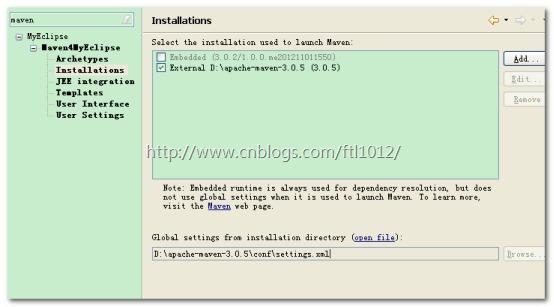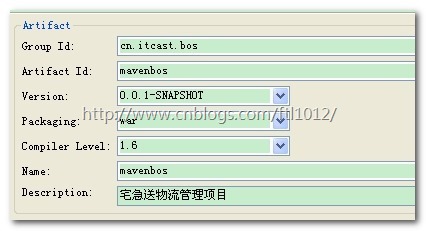Maven学习---使用maven进行项目构建
1. 使用maven进行项目构建
MyEclipse 自带maven 插件
Eclipse 需要单独安装maven插件
1.1. Maven 在企业中怎么用的 ?
Maven : 项目构建工具 ,进行项目编译、测试、打包、运行、发布 ….
使用 maven将工程进行组件化 ,项目分为 表现层、业务层、 数据层 属于maven创建 三个项目 ,分别进行三层开发
Maven 和 Jenkins (hudson) 对项目进行持续集成
企业中搭建私服
1.2. 建立maven骨架的项目,运行bos
1、 下载和解压 maven 的zip包
链接:https://pan.baidu.com/s/1Qt7alAjiHA0SsXlFuRpxrg 密码:kyan
2、 在myeclipse 配置外部 maven

3、 配置仓库setting文件 和 仓库位置
默认位置 C:\Users\Administrator\.m2 (这个文件夹没有 settings,xml )
将解压maven目录下的settings.xml 复制C:\Users\Administrator\.m2\settings.xml
<?xml version="1.0" encoding="UTF-8"?> <!--
Licensed to the Apache Software Foundation (ASF) under one
or more contributor license agreements. See the NOTICE file
distributed with this work for additional information
regarding copyright ownership. The ASF licenses this file
to you under the Apache License, Version 2.0 (the
"License"); you may not use this file except in compliance
with the License. You may obtain a copy of the License at http://www.apache.org/licenses/LICENSE-2.0 Unless required by applicable law or agreed to in writing,
software distributed under the License is distributed on an
"AS IS" BASIS, WITHOUT WARRANTIES OR CONDITIONS OF ANY
KIND, either express or implied. See the License for the
specific language governing permissions and limitations
under the License.
--> <!--
| This is the configuration file for Maven. It can be specified at two levels:
|
| 1. User Level. This settings.xml file provides configuration for a single user,
| and is normally provided in ${user.home}/.m2/settings.xml.
|
| NOTE: This location can be overridden with the CLI option:
|
| -s /path/to/user/settings.xml
|
| 2. Global Level. This settings.xml file provides configuration for all Maven
| users on a machine (assuming they're all using the same Maven
| installation). It's normally provided in
| ${maven.home}/conf/settings.xml.
|
| NOTE: This location can be overridden with the CLI option:
|
| -gs /path/to/global/settings.xml
|
| The sections in this sample file are intended to give you a running start at
| getting the most out of your Maven installation. Where appropriate, the default
| values (values used when the setting is not specified) are provided.
|
|-->
<settings xmlns="http://maven.apache.org/SETTINGS/1.0.0"
xmlns:xsi="http://www.w3.org/2001/XMLSchema-instance"
xsi:schemaLocation="http://maven.apache.org/SETTINGS/1.0.0 http://maven.apache.org/xsd/settings-1.0.0.xsd">
<!-- localRepository
| The path to the local repository maven will use to store artifacts.
|
| Default: ~/.m2/repository
<localRepository>/path/to/local/repo</localRepository>
--> <!-- interactiveMode
| This will determine whether maven prompts you when it needs input. If set to false,
| maven will use a sensible default value, perhaps based on some other setting, for
| the parameter in question.
|
| Default: true
<interactiveMode>true</interactiveMode>
--> <!-- offline
| Determines whether maven should attempt to connect to the network when executing a build.
| This will have an effect on artifact downloads, artifact deployment, and others.
|
| Default: false
<offline>false</offline>
--> <!-- pluginGroups
| This is a list of additional group identifiers that will be searched when resolving plugins by their prefix, i.e.
| when invoking a command line like "mvn prefix:goal". Maven will automatically add the group identifiers
| "org.apache.maven.plugins" and "org.codehaus.mojo" if these are not already contained in the list.
|-->
<pluginGroups>
<!-- pluginGroup
| Specifies a further group identifier to use for plugin lookup.
<pluginGroup>com.your.plugins</pluginGroup>
-->
</pluginGroups> <!-- proxies
| This is a list of proxies which can be used on this machine to connect to the network.
| Unless otherwise specified (by system property or command-line switch), the first proxy
| specification in this list marked as active will be used.
|-->
<proxies>
<!-- proxy
| Specification for one proxy, to be used in connecting to the network.
|
<proxy>
<id>optional</id>
<active>true</active>
<protocol>http</protocol>
<username>proxyuser</username>
<password>proxypass</password>
<host>proxy.host.net</host>
<port>80</port>
<nonProxyHosts>local.net|some.host.com</nonProxyHosts>
</proxy>
-->
</proxies> <!-- servers
| This is a list of authentication profiles, keyed by the server-id used within the system.
| Authentication profiles can be used whenever maven must make a connection to a remote server.
|-->
<servers>
<!-- server
| Specifies the authentication information to use when connecting to a particular server, identified by
| a unique name within the system (referred to by the 'id' attribute below).
|
| NOTE: You should either specify username/password OR privateKey/passphrase, since these pairings are
| used together.
|
-->
<server>
<id>myserver</id>
<username>tomcat</username>
<password>123456</password>
</server> <!-- Another sample, using keys to authenticate.
<server>
<id>siteServer</id>
<privateKey>/path/to/private/key</privateKey>
<passphrase>optional; leave empty if not used.</passphrase>
</server>
-->
</servers> <!-- mirrors
| This is a list of mirrors to be used in downloading artifacts from remote repositories.
|
| It works like this: a POM may declare a repository to use in resolving certain artifacts.
| However, this repository may have problems with heavy traffic at times, so people have mirrored
| it to several places.
|
| That repository definition will have a unique id, so we can create a mirror reference for that
| repository, to be used as an alternate download site. The mirror site will be the preferred
| server for that repository.
|-->
<mirrors>
<!-- mirror
| Specifies a repository mirror site to use instead of a given repository. The repository that
| this mirror serves has an ID that matches the mirrorOf element of this mirror. IDs are used
| for inheritance and direct lookup purposes, and must be unique across the set of mirrors.
|
<mirror>
<id>mirrorId</id>
<mirrorOf>repositoryId</mirrorOf>
<name>Human Readable Name for this Mirror.</name>
<url>http://my.repository.com/repo/path</url>
</mirror>
-->
</mirrors> <!-- profiles
| This is a list of profiles which can be activated in a variety of ways, and which can modify
| the build process. Profiles provided in the settings.xml are intended to provide local machine-
| specific paths and repository locations which allow the build to work in the local environment.
|
| For example, if you have an integration testing plugin - like cactus - that needs to know where
| your Tomcat instance is installed, you can provide a variable here such that the variable is
| dereferenced during the build process to configure the cactus plugin.
|
| As noted above, profiles can be activated in a variety of ways. One way - the activeProfiles
| section of this document (settings.xml) - will be discussed later. Another way essentially
| relies on the detection of a system property, either matching a particular value for the property,
| or merely testing its existence. Profiles can also be activated by JDK version prefix, where a
| value of '1.4' might activate a profile when the build is executed on a JDK version of '1.4.2_07'.
| Finally, the list of active profiles can be specified directly from the command line.
|
| NOTE: For profiles defined in the settings.xml, you are restricted to specifying only artifact
| repositories, plugin repositories, and free-form properties to be used as configuration
| variables for plugins in the POM.
|
|-->
<profiles>
<!-- profile
| Specifies a set of introductions to the build process, to be activated using one or more of the
| mechanisms described above. For inheritance purposes, and to activate profiles via <activatedProfiles/>
| or the command line, profiles have to have an ID that is unique.
|
| An encouraged best practice for profile identification is to use a consistent naming convention
| for profiles, such as 'env-dev', 'env-test', 'env-production', 'user-jdcasey', 'user-brett', etc.
| This will make it more intuitive to understand what the set of introduced profiles is attempting
| to accomplish, particularly when you only have a list of profile id's for debug.
|
| This profile example uses the JDK version to trigger activation, and provides a JDK-specific repo.
<profile>
<id>jdk-1.4</id> <activation>
<jdk>1.4</jdk>
</activation> <repositories>
<repository>
<id>jdk14</id>
<name>Repository for JDK 1.4 builds</name>
<url>http://www.myhost.com/maven/jdk14</url>
<layout>default</layout>
<snapshotPolicy>always</snapshotPolicy>
</repository>
</repositories>
</profile>
--> <!--
| Here is another profile, activated by the system property 'target-env' with a value of 'dev',
| which provides a specific path to the Tomcat instance. To use this, your plugin configuration
| might hypothetically look like:
|
| ...
| <plugin>
| <groupId>org.myco.myplugins</groupId>
| <artifactId>myplugin</artifactId>
|
| <configuration>
| <tomcatLocation>${tomcatPath}</tomcatLocation>
| </configuration>
| </plugin>
| ...
|
| NOTE: If you just wanted to inject this configuration whenever someone set 'target-env' to
| anything, you could just leave off the <value/> inside the activation-property.
|
<profile>
<id>env-dev</id> <activation>
<property>
<name>target-env</name>
<value>dev</value>
</property>
</activation> <properties>
<tomcatPath>/path/to/tomcat/instance</tomcatPath>
</properties>
</profile>
-->
</profiles> <!-- activeProfiles
| List of profiles that are active for all builds.
|
<activeProfiles>
<activeProfile>alwaysActiveProfile</activeProfile>
<activeProfile>anotherAlwaysActiveProfile</activeProfile>
</activeProfiles>
-->
</settings>
settings.xml

在 settings.xml 指定本地仓库位置

Maven 原理: 使用坐标导入jar包,先在本地仓库找,如果没有,会去网络上仓库下载 !
4、 将 repository.rar 解压,覆盖本机原来 的仓库
5、 在myeclipse 建立maven工程
可以自己选择骨架

quickstart 骨架, javase的maven项目
webapp 骨架, javaee的maven项目
² 使用simple project 骨架

输入maven参数
坐标 : GroupId 、ArtifactId 、Version
Packing 打包方式 : jar(给别人引入的)、pom(给别人继承的)、war (用来运行的)

maven 项目结构分析
src/main/java 存放项目源码
src/main/resources 存放项目配置文件
src/test/java 存放测试用例代码
src/test/resources 存放测试配置文件
src/main/webapp 文件夹用来存放页面代码
6、 移植项目
将源码 src/main/java
将配置文件 src/main/resources
将页面 src/main/webapp (WEB-INF 不要移动lib,只需要pages和web.xml )
7、 编写pom.xml
使用坐标导入 jar包

只需要获取 需要项目坐标,就可以引入
http://search.maven.org/
http://mvnrepository.com/
附参考pom.xml
<project xmlns="http://maven.apache.org/POM/4.0.0" xmlns:xsi="http://www.w3.org/2001/XMLSchema-instance"
xsi:schemaLocation="http://maven.apache.org/POM/4.0.0 http://maven.apache.org/xsd/maven-4.0.0.xsd">
<modelVersion>4.0.0</modelVersion>
<groupId>com.hauwei.bos</groupId>
<artifactId>mavenbos</artifactId>
<version>0.0.1-SNAPSHOT</version>
<packaging>war</packaging>
<name>mavenbox</name>
<description>XXXX管理项目</description>
<dependencies>
<!-- spring 3.2 -->
<dependency>
<groupId>org.springframework</groupId>
<artifactId>spring-context</artifactId>
<version>3.2.0.RELEASE</version>
</dependency>
<dependency>
<groupId>org.springframework</groupId>
<artifactId>spring-orm</artifactId>
<version>3.2.0.RELEASE</version>
</dependency>
<dependency>
<groupId>org.springframework</groupId>
<artifactId>spring-aspects</artifactId>
<version>3.2.0.RELEASE</version>
</dependency>
<dependency>
<groupId>org.springframework</groupId>
<artifactId>spring-web</artifactId>
<version>3.2.0.RELEASE</version>
</dependency>
<dependency>
<groupId>org.springframework</groupId>
<artifactId>spring-test</artifactId>
<version>3.2.0.RELEASE</version>
</dependency>
<!-- Struts 2 -->
<dependency>
<groupId>org.apache.struts</groupId>
<artifactId>struts2-core</artifactId>
<version>2.3.7</version>
</dependency>
<dependency>
<groupId>org.apache.struts</groupId>
<artifactId>struts2-json-plugin</artifactId>
<version>2.3.7</version>
</dependency>
<dependency>
<groupId>org.apache.struts</groupId>
<artifactId>struts2-spring-plugin</artifactId>
<version>2.3.7</version>
</dependency>
<!-- hibernate 3.6 -->
<dependency>
<groupId>org.hibernate</groupId>
<artifactId>hibernate-core</artifactId>
<version>3.6.10.Final</version>
</dependency>
<!-- JPA -->
<dependency>
<groupId>org.hibernate.javax.persistence</groupId>
<artifactId>hibernate-jpa-2.0-api</artifactId>
<version>1.0.1.Final</version>
</dependency>
<!-- Servlet & Jsp -->
<dependency>
<groupId>javax.servlet</groupId>
<artifactId>servlet-api</artifactId>
<version>2.5</version>
<scope>provided</scope> <!-- 只在编译和测试环境下使用,不参与打包运行,默认值Runtime -->
</dependency>
<dependency>
<groupId>javax.servlet</groupId>
<artifactId>jsp-api</artifactId>
<version>2.0</version>
<scope>provided</scope>
</dependency>
<!-- log4j -->
<dependency>
<groupId>org.slf4j</groupId>
<artifactId>slf4j-log4j12</artifactId>
<version>1.7.2</version>
</dependency>
<dependency>
<groupId>log4j</groupId>
<artifactId>log4j</artifactId>
<version>1.2.16</version>
</dependency>
<!-- C3P0 -->
<dependency>
<groupId>c3p0</groupId>
<artifactId>c3p0</artifactId>
<version>0.9.1.2</version>
</dependency>
<!-- mysql -->
<dependency>
<groupId>mysql</groupId>
<artifactId>mysql-connector-java</artifactId>
<version>5.1.6</version>
</dependency>
<!-- junit -->
<dependency>
<groupId>junit</groupId>
<artifactId>junit</artifactId>
<version>4.9</version>
<scope>test</scope>
</dependency>
<!-- poi -->
<dependency>
<groupId>org.apache.poi</groupId>
<artifactId>poi</artifactId>
<version>3.9</version>
</dependency>
<!-- 配置pinyin4j -->
<dependency>
<groupId>com.belerweb</groupId>
<artifactId>pinyin4j</artifactId>
<version>2.5.0</version>
</dependency>
<!-- 配置Hessian -->
<dependency>
<groupId>com.caucho</groupId>
<artifactId>hessian</artifactId>
<version>4.0.33</version>
</dependency> <!-- 配置Hessian-Search -->
<dependency>
<groupId>org.hibernate</groupId>
<artifactId>hibernate-search</artifactId>
<version>3.4.2.Final</version>
</dependency>
<!-- IK -->
<dependency>
<groupId>org.wltea</groupId>
<artifactId>IKAnalyzer</artifactId>
<version>2012_u6</version>
<scope>system</scope>
<systemPath>F:\ftl\mavenbox_day02\src\main\webapp\WEB-INF\lib\IKAnalyzer2012_u6.jar</systemPath>
</dependency> </dependencies>
<build>
<finalName>mavenbos</finalName>
<plugins>
<plugin>
<artifactId>maven-compiler-plugin</artifactId>
<configuration>
<source>1.6</source>
<target>1.6</target>
</configuration>
</plugin>
<plugin>
<groupId>org.apache.tomcat.maven</groupId>
<artifactId>tomcat7-maven-plugin</artifactId>
<version>2.1</version>
</plugin>
</plugins>
</build>
</project>
pom.xml
8、运行项目
右键项目 – run as --- maven build ---- tomcat:run

使用 maven tomcat plugin 1.1 进行运行
3.3. tomcat-maven-plugin 插件
早期插件 groupId : org.codehaus.mojo , artifactId : tomcat-maven-plugin 版本1.1

现在这个插件,被分为两个插件,坐标也改了


附文件:
<!-- tomcat plugin 分为tomcat6 和 tomcat7 两个插件 -->
<!-- http://mojo.codehaus.org/tomcat-maven-plugin/index.html -->
<plugin>
<groupId>org.apache.tomcat.maven</groupId>
<artifactId>tomcat7-maven-plugin</artifactId>
<version>2.1</version>
</plugin>
<plugin>
<groupId>org.apache.tomcat.maven</groupId>
<artifactId>tomcat6-maven-plugin</artifactId>
<version>2.1</version>
</plugin> <!-- 早期tomcat maven plugin 使用 -->
<plugin>
<groupId>org.codehaus.mojo</groupId>
<artifactId>tomcat-maven-plugin</artifactId>
<version>1.1</version>
<configuration>
<!-- tomcat6.x -->
<url>http://localhost:8080/manager</url>
<!-- tomcat7.x -->
<!-- <url>http://localhost:8080/manager/text</url> -->
<server>myserver</server>
</configuration>
</plugin> 远程访问 tomcat6 : tomcat-users.xml
<role rolename="manager"/>
<user username="tomcat" password="123456" roles="manager"/> 远程访问 tomcat7 : tomcat-users.xml
<role rolename="manager-gui"/>
<role rolename="manager-script"/>
<user username="tomcat" password="123456" roles="manager-gui, manager-script"/>
maven tomcat plugin
3.3.1. 修改内部运行 tomcat的端口
<!-- 对插件进行配置 -->
<configuration>
<port>80</port>
</configuration>
Maven学习---使用maven进行项目构建的更多相关文章
- Maven环境下多模块项目构建
Maven环境下多模块项目构建 一.新建项目 1.建立我们的父模块par 2.建立我们的子模块dao层 3.建立我们的子模块service层 4.建立我们的子模块web层 5.全部配置完成后,怎么把我 ...
- VUE2 第六天学习--- vue单文件项目构建
阅读目录 VUE2 第六天学习--- vue单文件项目构建 回到顶部 VUE2 第六天学习--- vue单文件项目构建 VUE单文件组件在Vue项目中,然后使用 new Vue({el: '#cont ...
- Maven学习- 使用Maven构建Web项目
从网上查了一些资料,才算明白(也就是怎么操作吧),怎么使用Maven构建一个Web项目,找到一篇文档,主要都是从这里学到的: 下载地址:使用Eclipse构建Maven的Web项目.docx 现自己在 ...
- 从初识Maven到使用Maven进行依赖管理和项目构建
前些天就安装了Maven,以备自己以后整合项目用,尤其是我们的ssh,ssm项目.想必好多人在开始的时候并不清楚Maven是什么,它能够帮助我们干什么. 所以在学习Maven之前我们一定要知道它是什么 ...
- Maven学习 五 Maven项目创建(1)jar项目
第一步:Maven项目的创建 File->new->Maven project. 点击下一步 上方的两个多选框选上,第一个是不使用archetype 原型模板,第二个是使用默认工作空间 点 ...
- maven 学习---使用Maven模板创建项目
在本教程中,我们将向你展示如何使用mvn archetype:generate从现有的Maven模板列表中生成项目.在Maven 3.3.3,有超过1000+个模板,Maven 团队已经过滤掉一些无用 ...
- maven 学习---使用Maven创建Java项目
在本教程中,我们将向你展示如何使用 Maven 来创建一个 Java 项目,导入其到Eclipse IDE,并打包 Java 项目到一个 JAR 文件. 所需要的工具: Maven 3.3.3 Ecl ...
- 使用Maven进行依赖管理和项目构建
什么是Maven 1 依赖的管理:仅仅通过jar包的几个属性,就能确定唯一的jar包,在指定的文件pom.xml中,只要写入这些依赖属性,就会自动下载并管理jar包. 2 项目的构建:内置很多的插件与 ...
- 保姆级神器 Maven,再也不用担心项目构建搞崩了
今天来给大家介绍一款项目构建神器--Maven,不仅能帮我们自动化构建,还能够抽象构建过程,提供构建任务实现:它跨平台,对外提供了一致的操作接口,这一切足以使它成为优秀的.流行的构建工具,从此以后,再 ...
随机推荐
- unity3d vscode
原来unity3d里assets store有一个插件,下载就行了,插件名就叫vscode 下载完了之后,preference里就会出现,vscode,Enable Integration 这一项勾上 ...
- 转: 将Eclipse代码导入到AndroidStudio的两种方式 ,测试了方法2,成功。
蛋疼,不知道为什么我的eclipse的logcat总是莫名其妙的显示一堆黄色字体的字,看不懂的那种,如下图: 然后查了一下资料,说可能是adt版本太低,手机系统太高. 然后本来想升级adt,但是各种折 ...
- Kubernetes单机安装部署
系统环境: Ubuntu 16.04.2 LTS 软件环境: Docker 1.12.6 Go 1.8.3 Etcd 3.1.8 Flannel 0.7.1 Kubernetes master 1.7 ...
- Delphi设置表格样式
//设置表格样式wordDoc.Tables.Item(1).Borders.Item(Word.WdBorderType.wdBorderLeft).LineStyle = Word.WdLineS ...
- Linux下MySQL出现乱码的解决方法
开发环境 cent os 6.5 mysql springboot duird 故障描述 本地开发环境没有任何问题,上传到服务器后发现提交的表单内容只要是中文直接变成 ??? 解决方式 错误尝试: 一 ...
- 【Docker】Docker是什么?怎么安装?怎么用?
从今天开始学习Docker,通过对网上资料的搜集与学习,记录一下. 是什么 ? Docker是一个基于LXC实现的类似于VMs的超轻量级虚拟机. 它与VMs的区别在于,VMs提供的是一个完整的操作系 ...
- 【随笔】nginx下的301跳转,两个域名指向同一个服务器ip
301跳转 页面永久性移走,通常叫做301跳转,也叫301重定向,301转向. 指的是当用户点击一个网址时,通过技术手段,跳转到指定的一个网站. 用以解决两个域名指向同一个服务器ip,当访问m.xxx ...
- Java中final修饰参数的作用
在方法参数前面加final关键字就是为了防止数据在方法体中被修改. 主要分两种情况:第一,用final修饰基本数据类型:第二,用final修饰引用类型. 第一种情况,修饰基本类型(非引用类型).这时参 ...
- 使用sqlcmd进行MS-dos方式查询
在windows选择‘运行’vista需要以管理员身份运行,打开命令提示符窗口 要连接到sql server服务器,必须指定服务器名称,安装命名实例中的,还必须指定实例名.默认情况下,sqlcmd使用 ...
- .Net程序员玩转Android系列之一~Java快速入门
前言 前段时间受公司业务发展需要,探索性进入Android开发领域.一切从零开始,java基础,Java进阶,Android框架学习,Eclipse熟悉,最终到第一个即时通讯App完成,历经一个月的时 ...
